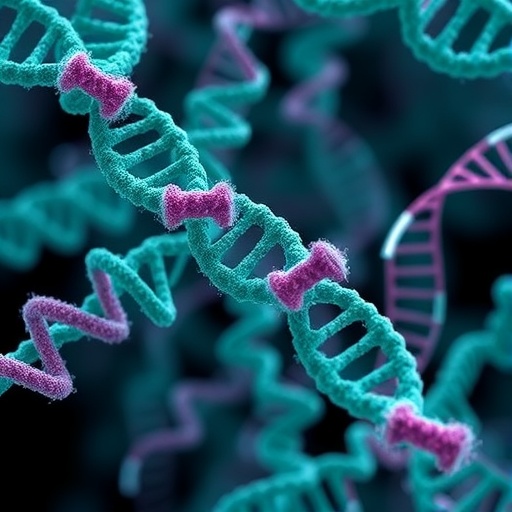
In a groundbreaking study from the Institute of Science Tokyo, researchers have unveiled the sophisticated dual-binding mechanism employed by the Fused in Sarcoma (FUS) protein to interact with RNA molecules. Through cutting-edge molecular modeling and simulations, the team has illuminated how the collaboration between a well-structured zinc finger (ZnF) domain and flanking intrinsically disordered regions (IDRs) enhances RNA binding specificity and stability. These findings promise to reshape our understanding of nucleic acid-protein interactions and open new avenues in biomolecular engineering and therapeutic design.
RNA-binding proteins are pivotal to cellular function, mediating processes ranging from RNA splicing and transport to translation regulation. Central to their function is the ability to discriminate specific RNA sequences while maintaining flexible binding dynamics. Traditionally, this has been a perplexing challenge given the presence of both highly ordered domains and disordered regions within these proteins. The recent work focusing on the FUS protein provides critical insight into how these divergent structural elements cooperate to achieve precise yet adaptable RNA binding.
The FUS protein is particularly notable due to its association with neurodegenerative disorders and its multifaceted role in gene regulation. Its architecture comprises a single-stranded RNA-binding RanBP2-type zinc finger domain, a well-defined structural motif responsible for sequence-specific recognition, coupled with extensive intrinsically disordered regions that lack fixed conformation. Leveraging molecular dynamics simulations enhanced by advanced sampling techniques, the researchers meticulously characterized how these domains engage with RNA sequences.
The simulations targeted a short RNA oligonucleotide containing a known FUS target sequence, GGU, to dissect the nature of the protein-RNA interface. What emerged was a compelling model involving two binding modalities: one dominated by the ZnF domain alone and another, more energetically favorable state where the disordered regions augment the interaction. Surprisingly, while the ZnF domain offered sequence specificity, its affinity was relatively modest when acting in isolation.
Intrinsically disordered regions, far from being passive linkers, actively participate in binding by making mostly non-specific contacts governed by electrostatic attractions to the phosphate backbone of the RNA. These transient yet multivalent interactions were shown to lower the dissociation constant significantly, effectively doubling the protein’s affinity for the RNA molecule. Furthermore, the IDRs induce conformational distortions in the RNA backbone, serving to stabilize the overall complex beyond the contribution of ZnF alone.
The integration of these dual binding modes results in a protein-RNA complex with an affinity nearly tenfold greater than that of the zinc finger domain alone. This cooperative binding not only enhances stability but also imparts the adaptability necessary for proteins to function in the dynamic intracellular environment. The study’s authors suggest that this mechanism may extend to a broader family of nucleic acid-binding proteins that possess similar domain architectures.
Importantly, the team’s sequence analysis of various RNA-binding proteins with associated IDRs revealed that the dual-binding model is likely a widespread phenomenon, indicating an evolutionarily conserved strategy to balance specificity and flexibility. This challenges prior assumptions that disordered regions serve purely structural or regulatory roles without direct involvement in molecular recognition processes.
Professor Akio Kitao, leading the study, emphasizes the active role of IDRs, “Our data suggest that these disordered segments are integral to RNA recognition and binding, vastly influencing interaction kinetics and affinity. This redefines our conceptual framework of protein-RNA recognition beyond static domain-specific contacts.” Such insights underscore IDRs as crucial functional elements rather than mere passive connectors, reshaping their perceived importance in molecular biology.
From a methodological standpoint, the study showcases the power of combining molecular dynamics with enhanced sampling to overcome the sampling limitations typically encountered in simulating flexible protein regions. This approach enabled capturing transient, non-specific interactions and subtle conformational changes previously difficult to observe, highlighting the value of computational simulation in revealing biomolecular mechanisms at atomic resolution.
The implications of these findings are profound, offering potential targets for rational drug design focused on modulating protein-RNA interactions. Therapeutics that can mimic or disrupt these dual binding modes may precisely influence gene regulatory pathways implicated in diseases such as amyotrophic lateral sclerosis (ALS) and certain cancers, where FUS and similar proteins are pivotal players.
Looking forward, the researchers plan to extend their investigations to explore whether post-translational modifications of intrinsically disordered regions influence their RNA-binding characteristics. Such modifications could dynamically modulate protein activity and specificity, contributing further complexity to gene regulation and cellular response mechanisms in health and disease.
This pioneering study provides a vital new paradigm in understanding how RNA-binding proteins combine structured and unstructured domains to fine-tune interactions at the molecular level. It marks a significant stride towards deciphering the sophisticated language of nucleic acid recognition, with wide-reaching implications for molecular biology, bioengineering, and therapeutic development.
Subject of Research:
Article Title: RNA Binding Mechanism of the FUS Zinc Finger in Concert with Its Flanking Intrinsically Disordered Region
News Publication Date: August 11, 2025
Web References: https://doi.org/10.1021/acs.jcim.5c01059
References: Journal of Chemical Information and Modeling, Volume 65, Issue 15, August 11, 2025
Image Credits: Institute of Science Tokyo, Japan
Keywords: Molecular biology, RNA-binding proteins, Zinc fingers, Intrinsically disordered regions, Protein-RNA interaction, Molecular dynamics simulation, RNA structure, Protein conformation, Gene regulation, Biomolecular recognition, Neurodegenerative diseases, Computational modeling
Tags: biomolecular engineering applicationsFused in Sarcoma proteingene regulation mechanismsintrinsically disordered regionsmolecular modeling techniquesneurodegenerative disorders researchprotein-RNA interactionsRNA binding specificityRNA splicing and transporttherapeutic design advancementszinc finger proteins




